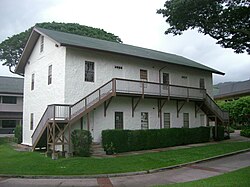Oahu College
| Punahou School | |
|---|---|

The center of the seal depicts a hala tree rooted on a spring with kalo on either side. Two night-blooming cereus flowers, which border the campus, are found on the seal's outer ring.
|
|
| Address | |
|
1601 Punahou Street Honolulu, Hawaiʻi 96822 United States |
|
| Information | |
| Type | Private, college-prep, day |
| Established | 1841 |
| President | James Kapaeʻalii Scott '70 |
| Faculty | 300+ |
| Grades | K-12 |
| Gender | Coeducational |
| Number of students | 3,000+ (approx.) |
| Campus | Urban |
| Color(s) | Buff and Blue |
| Athletics conference | Interscholastic League of Honolulu (ILH) |
| Team name | "Buffanblu" colloquially "Puns" or "Buff 'n Blue" |
| Rivals | Kamehameha, Iolani |
| Publication | Literary magazines: Kakela (6-8) Ka Wai Ola (9-12) |
| Newspaper | Ka Punahou |
| Yearbook |
Na ʻOpio (K-8) The Oahuan (9-12) |
| Website | http://www.punahou.edu/ |
|
Punahou School Campus
|
|

Old School Hall, built in 1851
|
|
| Coordinates | 21°18′10″N 157°49′50″W / 21.30278°N 157.83056°WCoordinates: 21°18′10″N 157°49′50″W / 21.30278°N 157.83056°W |
| Built | 1842 |
| NRHP Reference # | 72000419 |
| Added to NRHP | August 7, 1972 |
Punahou School (known as Oahu College until 1934) is a private, co-educational, college preparatory school located in Honolulu CDP, City and County of Honolulu in the U.S. State of Hawaii. With about 3,760 students attending the school, in kindergarten through the twelfth grade.
Founded in 1841, the school has a rich history and a wide variety of programs. Its most famous alumnus, the 44th President of the United States, Barack Obama, graduated in 1979. Along with academics and athletics, Punahou offers visual and performing arts programs. In 2006, Punahou School was ranked as the greenest school in America. The student body is diverse, with student selection based on both academic and non-academic considerations. In 2008 and 2009, Punahou's sports program was ranked best in the country by Sports Illustrated.
In 1795, the land known as Ka Punahou was taken in battle by King Kamehameha I. Along with Ka Punahou, he gave a total of 225 acres (0.91 km2) of land (from the slope of Round Top down to the current Central Union Church, which included a 77-acre (310,000 m2)-tract of Kewalo Basin) to chief Kameʻeiamoku as a reward for his loyalty. After Kameʻeiamoku died, the land was passed down to his son, Ulumāheihei Hoapili, who lived there for twenty more years. When Hoapili left to become the governor of Maui, he gave the land to his daughter, Kuini Liliha.
...
Wikipedia

